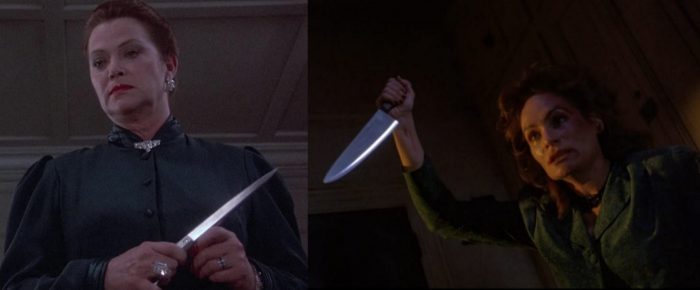Based on V. C. Andrews’ 1979 novel of the same name, Jeffrey Bloom’s Flowers in the Attic is a little better than some critics suggest. That’s not to say you’ll love it, but let me go through a few details here and make a light defense of the film. To begin with, plenty of horror fans will come forward and suggest it’s not a horror film. While I understand the sentiment, my initial response is usually, “Who cares?” However, I do think there are plenty of horror elements here. In fact, it doesn’t hurt that Wes Craven was originally considered to direct it. Obviously, if you’ve read the title, I think this movie has themes similar to those found in The People Under the Stairs, and I’ll elaborate more on that in a bit.
The second predictable critique of Flowers in the Attic will be of the acting. Yet again, I understand the criticism. Victoria Tennant, Kristy Swanson, and Jeb Stuart Adams don’t offer the most commanding performances committed to film. However, let’s not forget about Louise Fletcher, who definitely takes control of this film, giving a performance similar to what she accomplished in One Flew Over the Cuckoo’s Nest. As you watch, you may be enraged by her, as she puts everyone through hell due to sins of the past.
The result should make us ask: Should one’s perceived morality justify unrelenting cruelty? Might that urge exist beforehand, with the sadistic impulse requiring righteous justification? In fact, could it be that justification itself adds to the depravity of our actions, by masking punishment as a virtue? All of these disturbing (and, let’s face it, semi-kinky) questions unfold in Flowers in the Attic.
A Strange Tale
So, what specifically happens in this story? (Obviously, one might wish to avoid reading further if they don’t want any kinds of “spoilers.”) After the death of her husband (Marshall Colt), Tennant’s character, Corrine, moves into the mansion of her estranged father, Malcolm (Nathan Davis). She hopes her father will forgive her, then rewrite his will to hand over his estate after his death. However, Corrine’s mother, played by Fletcher, is perpetually going to punish Corrine and her children, Chris (Adams) and Cathy (Swanson) and 5-year-old twins Cory (Ben Ganger) and Carrie (Lindsay Parker).
Basically, these kids are, well, “kidnapped” for years by their grandmother’s estate as their mom tries to gain her father’s love (and fortune). At the same time, they are all ostensibly waiting for his funeral to escape the grandmother’s sadism. The siblings are imprisoned, only getting a sense of freedom when she’s out. Things get desperate when their mother gradually abandons them, with no plans to sneak the children out of the house. Basically, her greed ends up trumping their need.
Symbolism and the Comparison You Came Here For
Aside from flowers and an attic, Flowers in the Attic has some symbolism built into the plot. Obviously, these children live where their mother lives, yet they might as well be separated by thousands and thousands of miles. They first arrive in town as strangers to their grandmother, even though they’re related. It’s not like they have no place to stay, but end up feeling like they’d be better off lost. These are all themes of abandonment. Also, even though their grandmother considers herself well-raised and moralistic, she’s no better than the proverbial slob raised in a barn.
Again, people sometimes question if this is horror, but some of these family members are no better than deranged killers. In fact, considering that Wes Craven was considered to direct, I can’t help but wonder if this story partly influenced Craven’s later film, The People Under the Stairs. Both feature characters too psychologically damaged to defend themselves against their wealthy captors. Noticeably, they are basically disarmed (none of the victims carry a gun). Both stories feature perverted mother and father roles.
Then, of course, you have imagery like the attic door or, in The People Under the Stairs, kidnapped children locked away in a basement. In Flowers in the Attic, when the kids see their grandfather for the first time, it’s not like the old man simply refuses to accept them — he attacks them and seems like a monster.
Really, the main difference is that, in Flowers, the grandmother has hired some henchmen who prevent the kids from escaping. In People, the Mommy (Wendy Robie) and Daddy (Everett McGill) characters compel kids (Brandon Adams, A. J. Langer) into hiding, too. As perhaps the ultimate thematic crossover, kids also end up spying through walls in Flowers in the Attic. Though it lacks the bloody scenes prominent in The People Under the Stairs, the adults in Flowers in the Attic seem perfectly capable of burying young bodies in the woods.
One Last Bit of Trivia
The final scene of Flowers was filmed at Greystone Mansion in Beverly Hills, California. The 2007 film There Will Be Blood also filmed parts at Greystone Mansion, as well as films like Austin Powers in Goldmember, The Big Lebowski, Cabin Boy, Death Becomes Her, Eraserhead, Ghostbusters II, The Golden Child, The Muppets (film) (Kermit’s mansion), Sam Raimi’s Spider-Man franchise, Stripes, and The Witches of Eastwick. Also, soap operas like The Young and the Restless and The Bold and the Beautiful have used the location, and even the music video to “I’d Do Anything for Love (But I Won’t Do That)” by Meatloaf features Greystone.
What are your thoughts on Flowers in the Attic? Is it similar at all to The People Under the Stairs or does this idea belong locked away in a basement or attic?

